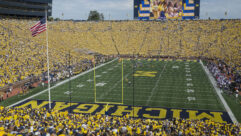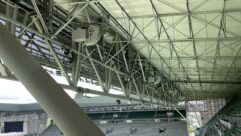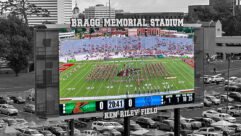
The Buzz: Install of the Month: Stadium Theatre, Woonsocket, R.I.
Oct 1, 2006 12:00 PM
Opulence Reclaimed

Restoration of the Stadium Theatre included installing a new Mackie Onyx 4880 console and EAW AX396 loudspeakers to create a balanced sound system.
Built in 1926, the Stadium Theatre in Woonsocket, R.I., was a performance space that hosted top vaudeville performers, organ concerts, and feature films. Local industrialist Arthur Darman funded the building of the theater with $1 million of his own money, a true fortune at the time, and intended the building as an affordable entertainment outlet that would rival experiences offered at nearby New York and Boston venues.
Fast-forward to the early 1990s, when the nonprofit and all-volunteer Stadium Theatre Foundation set out to restore the venue, which by that point had been shuttered for more than 20 years, to its original grandeur. In 2001, after the group had raised more than $3 million, the Stadium Theatre reopened on its 75th anniversary.
Under the direction of the foundation, architect Dan Peloquin (a foundation member), and the John Canning Preservation and Restoration Studios, the grand hall was restored to it previous ornate aesthetic, while retaining its initial configuration. Even the original Wurlitzer pipe organ has been returned to its original condition.
“The restoration was really done right, resulting in a gorgeous room. People were in awe,” says Peloquin, who also serves as the theater’s technical director.
But the revitalized grand hall was still lacking a key component: a sound reinforcement system able to accommodate the venue’s demanding schedule, which includes more than 90 events a year, including full-scale concerts, theatrical productions, and lectures. Upon reopening, the Stadium Theatre’s audio system was a mismatch of improperly applied components that often had to be supplemented by rental components.
The shoebox-shaped room, with about 1,100 seats split between the main floor, balcony, and side boxes, offers a warm, natural acoustical signature. The only acoustical treatment done in the renovation was the addition of some absorptive panels to the back wall to lessen the reintroduction of sound back into the audience area.
The foundation approached area resident Kenton Forsythe, co-founder of Eastern Acoustic Works (EAW), for his input. That relationship kicked off a project involving Providence, R.I.-based sound/production company ATR/Treehouse; Mary Cook, Scott Jordan, and Joe Fustolo of the EAW Application Support Group (ASG); and representatives of the theater and foundation, all working together to develop a suitable new sound reinforcement system.
The ultimate goal was to attain full, even coverage of the room from front to back and side to side, and accomplishing that goal without obscuring the visage was a crucial requirement.
The sound team built an EASE model to help determine loudspeaker choice, location, and angling. It decided on a basic left-center-right (LCR) configuration, with left and right clusters offering a stereo image, and a single center loudspeaker providing voice/spoken word reinforcement. “The goal is vocal intelligibility to the highest degree possible, but with an ability to ‘stomp’ the system for more full-range, dynamic musical applications when needed,” Cook explains.
This design path led to the selection of EAW AX396 full-range loudspeakers, offering a 90°×60° coverage pattern. The team decided the AX series speakers addressed Stadium Theatre’s unique challenges with their smooth frequency response, consistent polar patterns over a wide operating bandwidth, and vocal clarity.
Left and right clusters, flown more than 20ft. feet above the main floor, are oriented vertically. Both are topped by a single AX396 and followed by two AX122 dual 12in.-loaded subwoofers for low-end extension. The AX series subs and full-range loudspeakers benefit from a trapezoidal cabinet that allows the clusters to be tightly arrayed. The center loudspeaker is an AX396 tucked against the apex of the stage proscenium. To give it an even lower profile, it was mounted horizontally, with the horn then rotated to attain the desired coverage pattern.
With the main loudspeakers positioned so high above the main floor, four EAW UB12S compact loudspeakers were also specified to provide front-fill to the first few seating rows.
All the loudspeakers are driven by EAW Commercial power amplifiers rack-mounted in a remote upper-floor room adjacent to the stage area. Seven model CAZ2500 amps are dedicated to the house loudspeakers (biamp mode) and subwoofers (bridged mono). A single CAZ1400, also in bridge-mono mode, powers the four front-fill loudspeakers.
An EAW MX8750 digital signal processor joins the amps in the rack. Four output channels of the 8-channel unit are dedicated to left and right full-range loudspeakers (two channels each), and two more channels provide mono-summed output to the center loudspeaker. Another mono-sum output feeds the subwoofers, with the remaining channel left open, where it can be used to tie in stage monitoring systems often brought in by visiting artists.
Audio rigging designer/manufacturer Polar Focus was brought in to develop flying hardware, and in particular to formulate the unusual arrangement of the left and right clusters. The solution selected was a specially formulated combination of the company’s unique Zbeam fly-bar that provides total pan-and-tilt control, along with custom cable kits and other necessary hardware.
ATR/Treehouse handled the rest of the system installation, including the new Mackie Onyx 4880 console at the house mix position, located centrally on the main floor. The Onyx console was selected for a variety of reasons, with ease of use and plenty of channels topping the list, in addition to pro-caliber performance and features at a reasonable price. Given the extreme differences in expertise on the part of its users from night to night, the console also had to be operator-friendly, while still meeting rider expectations.
“In general, this system is very easy to operate,” Peloquin says, “and the Mackie console is just right, simple yet great sounding.”
The console accommodates productions that wish to use their other outboard effects and other processing gear. In addition, the added inputs are handy for things like expanding the number of wireless microphone systems, exemplified by a recent production where 10 extra units were rented so that every performer could be outfitted with his or her own system.
House equalization was established in the processor, and any system EQ changes can be made via the console only.
ATR/Treehouse also developed a sequential power system for the amplifiers and processor. Not only does it properly power up/down the system, but it also provides a “key” for doing so. “With all of the users we have, it’s great that they only need to be responsible for one thing: to turn on and off the entire system,” Peloquin says.
“It’s such a balanced system, with no hot or dead spots,” he adds. “It maximizes the enjoyment of the audience regardless of the performance.”
Subscribe to Sound & Video Contractor e-newsletters!
Sound & Video Contractor EXTRA
Systems Integration Special Focus series:
Houses of Worship
Corporate AV
Residential AV
AV Over Fiber
AV in Education
Breaking industry news in your email inbox every other week! Subscribe at www.svconline.com.










